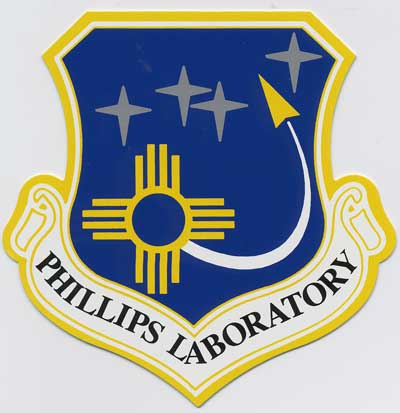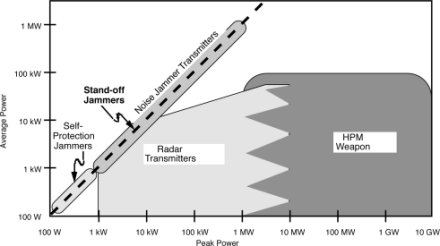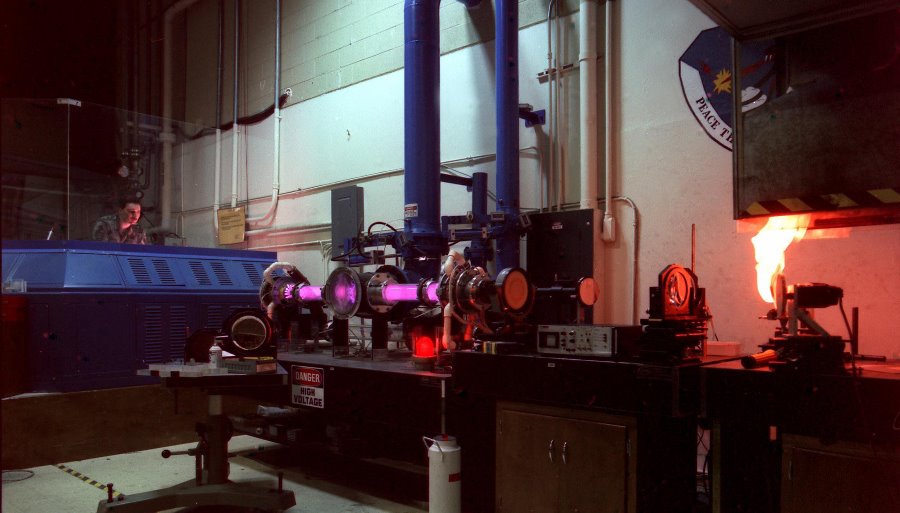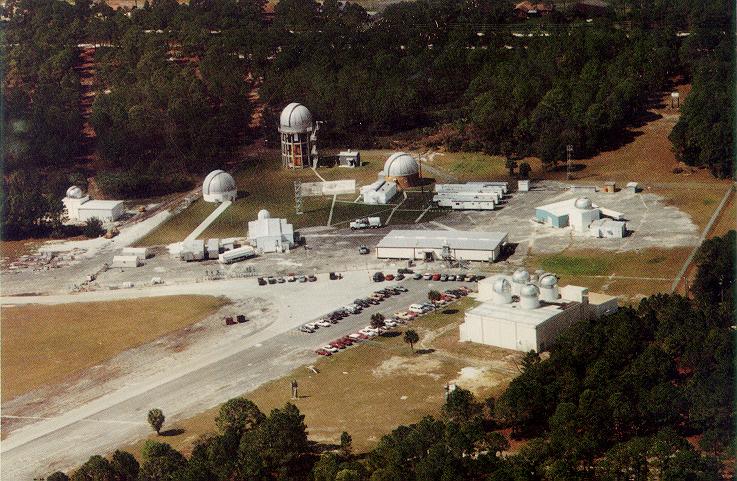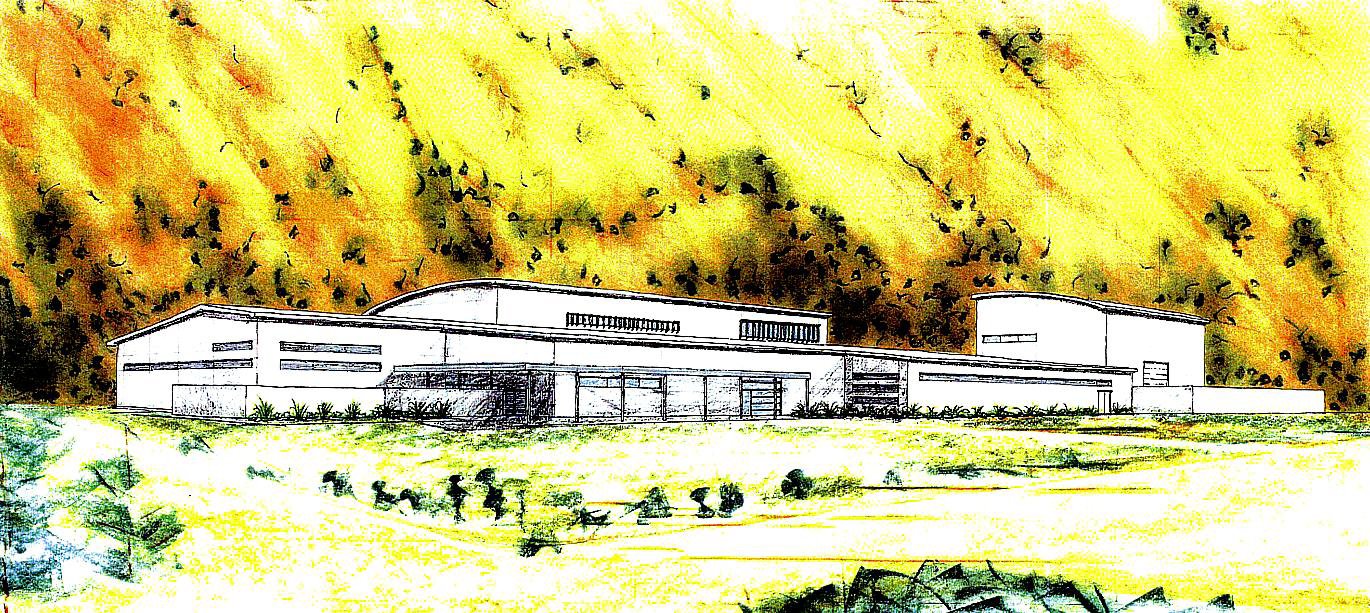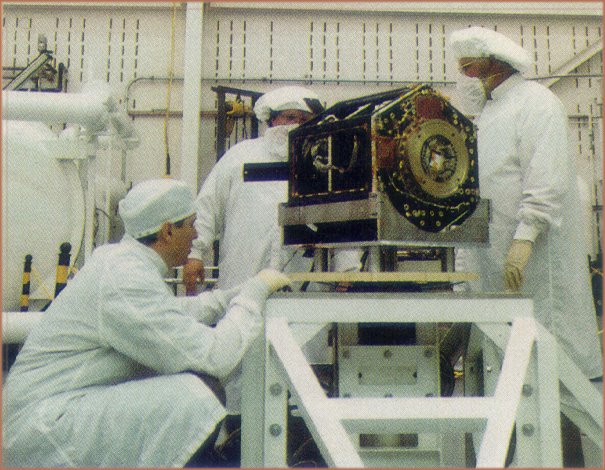|
Phillips Lab Particle Accelerator Particle Beam Weapons Research |
||
|
||
| Data Report of Hypervelocity
Micro-Particle Impact Light Flash Data and MOS Impact Detector Output.
Accession Number : ADA296741
Corporate Author : PHILLIPS LAB
KIRTLAND AFB NM
Abstract : A series of hypervelocity impact tests were conducted at the Max-Plank Institut fur Kernphysik, Heidelberg, Germany using the Institut's 2 MV Van De Graaff micro-particle accelerator. The purpose of this experimental effort was to collect impact flash data resulting from hypervelocity impact events. The results of these test experiments are to be correlated with actual waveforms obtained from on-orbit systems. Furthermore, these experimental results will supplement ongoing theoretical predictions being conducted within the Phillips Laboratory by the Space Kinetic Impact/Debris Branch (pLJWSCD). This report only describes the instrumentation configuration and presents data collected from light flash measurements and a MOS micro-particle impact detector. An analysis of the acquired light flash data is contained in a separate report authored by Allahdadi, Medina, Serna, and Long. Iron particles in the mass range of 1 x 10 to the -15th to 8 x 10 to the -18th kg were accelerated to velocities between 7 and 38 km/sec. Three targets were used for these impact test: spacecraft optical lens, spacecraft optical sunshade, and MOS spacecraft micro-particle impact detector. The hypervelocity particle impacted the lens and micro-particle impact detector targets normal to the target surface. The sunshade was impacted at a 25 degree angle measured from the particle direction of flight. (MM) Descriptors : *HYPERVELOCITY IMPACT, *IMPACT TESTS, *PARTICLE COLLISIONS, *IMPACT FLASH, TEST AND EVALUATION, VELOCITY, OPTICAL PROPERTIES, SPACECRAFT, DETECTORS, IMPACT, DEBRIS, SPACE ENVIRONMENTS, VOLTAGE, LIGHT SOURCES, CONFIGURATIONS, DATA ACQUISITION, PHOTOMULTIPLIER TUBES, PHOTODIODES, HYPERSONIC VELOCITY, ACCELERATED TESTING, OPTICAL LENSES, CRATERS, LIGHT EMITTING DIODES, PARTICLE ACCELERATORS. Subject Categories : EXPLOSIONS
Distribution Statement : APPROVED FOR PUBLIC RELEASE
|
||
| Scaling studies of collective
ion acceleration with intense relativistic electron beams
This document is not available
electronically via this database.
|
||
| Introducing the Particle-Beam
Weapon
Dr. Richard M. Roberds Richard M. Roberds (B.A., M.S., University of Kansas; Ph.D., Air Force Institute of Technology) is Associate Professor and Head of the Engineering Technology Department at Clemson University. He is a retired Air Force colonel and was the first technical program manager of the Air Force particle-beam technology program, serving in that capacity from September 1975 until July 1977 at the Air Force Weapons Laboratory, Kirtland AFB, New Mexico. Colonel Roberds is a Distinguished Graduate of Air Command and Staff College and a graduate of the Industrial College of the Armed Forces. PAPER: http://www.airpower.maxwell.af.mil/airchronicles/aureview/1984/jul-aug/roberds.html |
||
| The Air Force Office of Scientific
Research, AFRL AFOSR
Dr. Robert J. Barker Dr. Barker is AFOSR's program manager for plasma physics in the Directorate of Physics and Electronics. He is an internationally recognized expert in the fields of plasma physics, microwave generation, and computational physics. His stature led Dr. Robert Trew, the Department of Defense's Director of Research, to publicly state "Bob Barker is the champion for plasma physics within the DOD." Dr. Barker's technical expertise has benefited numerous Air Force and Navy Research and Development programs on such topics as low observables, high power microwave (HPM) generation, chemical/biological decontamination, particle beam physics, computational plasma physics, explosive power generation, vacuum electronics, hypersonic drag reduction, and advanced wargaming. Dr. Barker is also colonel in the Air Force Reserves assigned as HPM Special Projects Manager at AFRL's Directed Energy Weapons Directorate at Kirtland Air Force Base, N.M. Prior to his current assignment, he served as the Senior Reservist for Armstrong Laboratory, AFOSR, and the Geophysics Laboratory since 1986. He has also served as Air Force Academy Admissions Liaison Officer and as an Intelligence Officer. He is a graduate of Air War College. SOURCE: http://www.afosr.af.mil/AboutAFOSR/about_fell_barker.htm |
||
| Air Force Research Lab Headquarters
(Phillips Lab)
Name: Air Force Research Lab Headquarters (Phillips
Lab)
Description:
The Air Force Research Lab (called Phillips Laboratory
until 2000), is headquartered at Kirtland Air Force Base. The Laboratory
is one of the Air Force's major research and development labs, and is a
focal point for all space- and missile-related research and technology;
including geophysics, propulsion, space vehicles, survivability, and directed-energy
weapons. The Laboratory has an annual budget of over $600 million and has
nearly 1,900 military and civilian employees at three locations: Kirtland
Air Force Base, New Mexico; Hanscom Air Force Base, Massachusetts;
and Edwards Air Force Base, California. It is part of Air Force Materiel
Command and reports to and supports the Space and Missile Systems Center
at Los Angeles Air Force Base, California.
Location: S Albuquerque, on Kirtland Air Force
Base
Address: NM Links: http://www.afrl.af.mil/ LCS: Aerospace R&D, Military, Weapons / Defense R&D |
||
|
..
Directed Energy Weapons include laser, high power radio frequency (HPRF), and particle beam technologies (HPRF technology is frequently called high power microwave (HPM) or RF directed energy). Electronic equipment can be defeated or impaired by irradiation from directed energy (DE) sources. Degradation can range from temporary "upsets" in electronics subsystems, permanent circuit deterioration, or permanent destruction due to burnout or electrical overload. As modern systems and their components become ever more reliant on sophisticated electronics, they also become more vulnerable to DE radiation. Near-term goals for RFE weapons
include the development of new HPRF source concepts, such as the interference
modulation HPM source concept and frequency agile, broadband klystrons
for use in susceptibility testing and in field tests. A mid-term goal is
the development of high-gain, broadband antennas. Long-term goals include
use of chaos theory research results to achieve greater control of RF weapon
sources. High power RF generators need to be smaller, lighter, and more
fuel efficient. Projected targets require intensive susceptibility studies
to determine the best attack methods. These technical challenges will be
overcome by concentrating technology development efforts on improving modulators,
RF sources, and antennas. Improvements to reduce size, weight, and power
requirements must also be accomplished by enhancements to radiation beam
control.
The High Energy Research and Technology Facility (HERTF) at Kirtland Air Force Base, New Mexico, is a premier Phillips Laboratory capability for research, development and transition of advanced weapons technologies. This $9 million facility provides a unique capability for the development of high-power microwaves, high-energy advanced pulsed power (including explosive devices), and very- high-energy plasmas. It also provides a research environment for exploring a variety of related technologies. The facility's remote location in the Manzano Mountains is coupled with aunique construction, which is designed to withstand blasts and intense radiation from a variety of sources, including high-energy microwaves and x-rays. HERTF is located in a canyon in the Manzano Mountains in the southeast portion of Kirtland. The facility has a four-story-high bay laboratory, 80 feet by 150 feet, with concrete roof and walls four feet thick for blast and radiation shielding. The high bay includes two bridge cranes, cable trays, a 12-foot-deep pit for intense radiation source experiments, and access tunnels to an explosive firing area near the high bay. Up to 1000 pounds of high explosives can be detonated in this area to produce hundreds of megajoules of electrical energy needed for these advanced experiments. The facility also contains offices and smaller laboratories where advanced weapons technology experiments and demonstrations can be conducted safely and securely. HERTF was designed to scale high-power microwave and high-energy plasma concepts that were pursued for many years in the Laboratory's basic research and exploratory development efforts. It was difficult to advance these concepts with the limited facilities available before HERTF was completed. With this facility, technologies can be advanced to a weapons level. Also, advanced weapons environments can be created, allowing scientists to assess the potential threat of these weapons to United States military systems. Although the Laboratory's high-power microwave technology is considerably advanced, HERTF is essential in conducting many of the critical experiments still needed to assess the feasibility of the technology for operational systems. Compact, high-energy pulsed power is an enabling technology for many advanced weapon concepts and effects simulation devices. HERTF is designed to play a major role in the Phillips Laboratory' s development of "next generation" high-energy pulsed power devices. Research and development includes the generation and conditioning of large amounts of electrical energy needed for advanced weapon technologies. High-energy plasma work at HERTF allows a dramatic power increase for compact toroid experiments compared to other Phillips Laboratory facilities, such as a 10-megajoule capacitor bank. These high-energy plasmas provide the intense radiation environment needed to simulate threat-level nuclear-weapon effects in space. These plasmas are used to support research on fusion energy, and they permit Laboratory scientists to assess potential space-weapon concepts. SOURCE: FAS.ORG Resources: High Energy Research and Technology Facility (HERTF)
|
||
|
..
The Laser Effects Test Facility of the Air Force Research Laboratory’s Directed Energy Directorate conducts experiments for the Laboratory, Department of Defense, Department of Energy, as well as other government agencies, U.S. industry, and universities. The facility’s primary objective is to perform research to better understand the physics of laser interactions on various materials. The test facility has a variety of unique test equipment
to support experiments, to include the most powerful
SOURCE: AFRL Fact Sheet PDF |
||
|
Malabar Test Facility ..
The OL-AG, Phillips Laboratory's mission is to perform real-time tracking of space objects, to use various sensors to study the effects of physical phenomena on space vehicles, to develop and test new sensors and electrooptical devices, and to provide tracking support for Kennedy Space Center(KSC) and Cape Canaveral Air Force Station (CCAFS) launches. The Malabar test facility was opened in the early 1960s to study lasers and laser effects. Subsequently, it was transferred to the Space and Missile Systems Organization (SAMSO) in 1978, Air Force Space Technology Center (AFSTC) in 1984, and Phillips Laboratory in 1990, where it now supports all DoD customers in the setup, evaluation, and performance of a wide range of electrooptical experiments. The primary resources of OL-AG, Phillips Laboratory include two optical trackers, two laser transmitters, a large computer system, and image and data processing capabilities to support such missions as launches from KSC and the Eastern Test Range, offshore operations, and on-orbit observations. Primary facilities include R1, a 1.2-m visible telescope with
four focal points from f/2.5 to f/100;
RESOURCES
|
||
|
(TACLab) ..
Under construction is a Telescope & Atmospheric
Compensation Laboratory (TACLab), which will be located in the southeast
portion of Kirtland Air Force Base, New Mexico, at the Starfire Optical
Range, a major capability at the Air Force Research Laboratory’s Directed
Energy Directorate. The $15.5 million TACLab will include a 52,000 square
foot building supporting advanced optical beam control, laser propagation,
and space object imaging research and
This facility will include extensive optics, electronics,
computer, and mechanical laboratory space for equipment design, construction,
and testing before integrating with telescopes and other experiment hardware.
The building will
SOURCE: AFRL Fact Sheet PDF |
||
| Tapered tube, microsecond electron
beam gyrotronbackward-wave-oscillators
Gilgenbach, R.M. Walter, M.T.
Menge, P.R. Spencer, T.A.
This paper appears in: Particle Accelerator Conference,
1993., Proceedings of the 1993
Abstract Experiments have been performed to test microwave efficiency enhancement and pulselength extension of the gyrotron-backward-wave-oscillator (gyro-BWO) through the use of a tapered interaction tube. The MELBA accelerator has been utilized to generate electron beams with parameters: V=-0.7 to -0.8 MV, I=1-4 kA, and pulselengths from 0.5-1 ?s. The microwave frequency is magnetically tunable in the range from 4.6-6 GHz. MAGIC code modeling has guided the experimental selection of taper magnitudes to enhance efficiency and pulselength. The optimal taper magnitude found in both the experiment and model has been a 10% downtapered tube, which gave a significant increase in both microwave tube power (factor of ~2, up to about 80 MW) and pulselength (≈30 % average increase up to 0.38 ?s) over uniform tubes. Integrated microwave pulse-energy is also maximized for the 10% downtapered tube. Taper magnitudes larger than 10% gave reduced microwave power and energy. SOURCE: IEEE |
||
|
Military Spaceplane Technology (MiST) Program
This patch is from the Phillips Laboratory Military Spaceplane Technology (MiST) Program Office at Kirtland Air Force Base in New Mexico. The original version of the patch sported an "X-Wing" fighter from the Star Wars movies. When lawyers representing George Lucas delivered the unit a cease and desist order, the aircraft on the patch was changed into the shape that appears in this patch. SOURCE:
|
||
| Relativistic L-Band Magnetron
Experiments Driven by a Microsecond e-Beam Accelerator
Intense Energy Beam Interaction Lab Nuclear Engineering and Radiological
Sciences Department
ABSTRACT
This research program investigates
high power microwave generation utilizing a microsecond electronbeam accelerator to drive a
relativistic magnetron. Peak microwave power levels have been achievedexceeding 200 MW total (100
MW per-cavity for two-cavity extraction) from a six-vane structure. Timefrequencyanalysis shows that microwave
emission is primarily single-mode with a total pulse duration inthe range of 50-100 ns. Relativistic
magnetron end-loss current measurements have been performed.Preliminary total efficiency
estimates for the relativistic magnetron are in the range of 13%, includingendloss current. If endloss
current is subtracted, the magnetron electronic efficiency nearly doubles
to 25%.The goal of future research
is to explore techniques for increasing the microwave power, efficiency
andpulselength of relativistic
magnetrons.
SOURCE: UMICH-SPIEpaper-2001.pdf |
||
| Experimental Investigation of
Emittance Growth in Particle Beams Using Directly Heated Lanthanum Hexaboride
Cathodes.
Accession Number : ADA199648
Corporate Author : AIR FORCE
WEAPONS LAB KIRTLAND AFB NM
Abstract : This report presents the theory of nonlinear field energy as applied to emittance growth in a space charge dominated particle beam. An experiment to validate this theory is described and the experimental apparatus and results are presented. The experimental apparatus is designed around a directly heated lanthanum hexaboride (Lab6) cathode which yields a variable radial intensity electron distribution. We report the first use of such an electron gun, and its initial operating characteristics, which compare favorably with predicted theory. Keywords: Emittance growth, Particle beams; Lanthanum hexaboride; Cathodes; Nonuniform radial intensity distribution; Electron gun. (sdw) Descriptors : *CATHODES(ELECTRON TUBES), *LANTHANUM COMPOUNDS, *PARTICLE BEAMS, BORIDES, ELECTRON GUNS, EMITTANCE, ENERGY, GROWTH(GENERAL), HEAT, INTENSITY, NONLINEAR SYSTEMS, NONUNIFORM, RADIUS(MEASURE), SPACE CHARGE, SPATIAL DISTRIBUTION. Subject Categories : THERMODYNAMICS
Distribution Statement : APPROVED FOR PUBLIC RELEASE
|
||
|
..
Mightysat-I. was launched into a 388x401km orbit inclined at 51.6 degrees on the 14th December 1998 as a Hitchhiker payload (employing the H.Ejection System) on Endeavour STS-88. It was deployed towards the orbit normal, after which the orbiter manoeuvred away. The technology demonstration satellite bus built originally by CTA ( since then acquired by Orbital Sciences), with a payload comprising several experiments, integrated by and procured by the US Air Force Phillips labs. These include a lightweight carbon fibre composite structure, advanced solar cells (Gallium Indium Phosphide layer on a Gallium Arsenide layer). Also included are "MAPLE", an advanced packaging method, "SMARD", a low shock separation system, "MPID" to establish man-made and natural space debris. It also includes materials to be tested in the space environment The spacecraft attitude control is by flat spin in the orbit plane. The experimental satellite was placed into a 468km orbit inclined at 52 degrees. The satellite weighs 67.5kg, and was planned to operate for 1 year, and decayed on the 21st November 1999. Mightysat-2.1 and MightySat-2.2 and follow on missions are minisatellites (future minisats). The first three pictures captured from NASA TV by Florida Today Space News Online show the deployment. [Picture #1][Picture #2][Picture #3][Shuttle deployment of small payloads at GSFC] SOURCE: Small Satellites Home Page |
||
|
DEW Projects ..
YAL-1A Attack Laser
ADS - Active Denial System
Career Opportunities
|
||
| FAIR USE NOTICE: This page contains copyrighted material the use of which has not been specifically authorized by the copyright owner. Pegasus Research Consortium distributes this material without profit to those who have expressed a prior interest in receiving the included information for research and educational purposes. We believe this constitutes a fair use of any such copyrighted material as provided for in 17 U.S.C § 107. If you wish to use copyrighted material from this site for purposes of your own that go beyond fair use, you must obtain permission from the copyright owner. | ||
|
|
